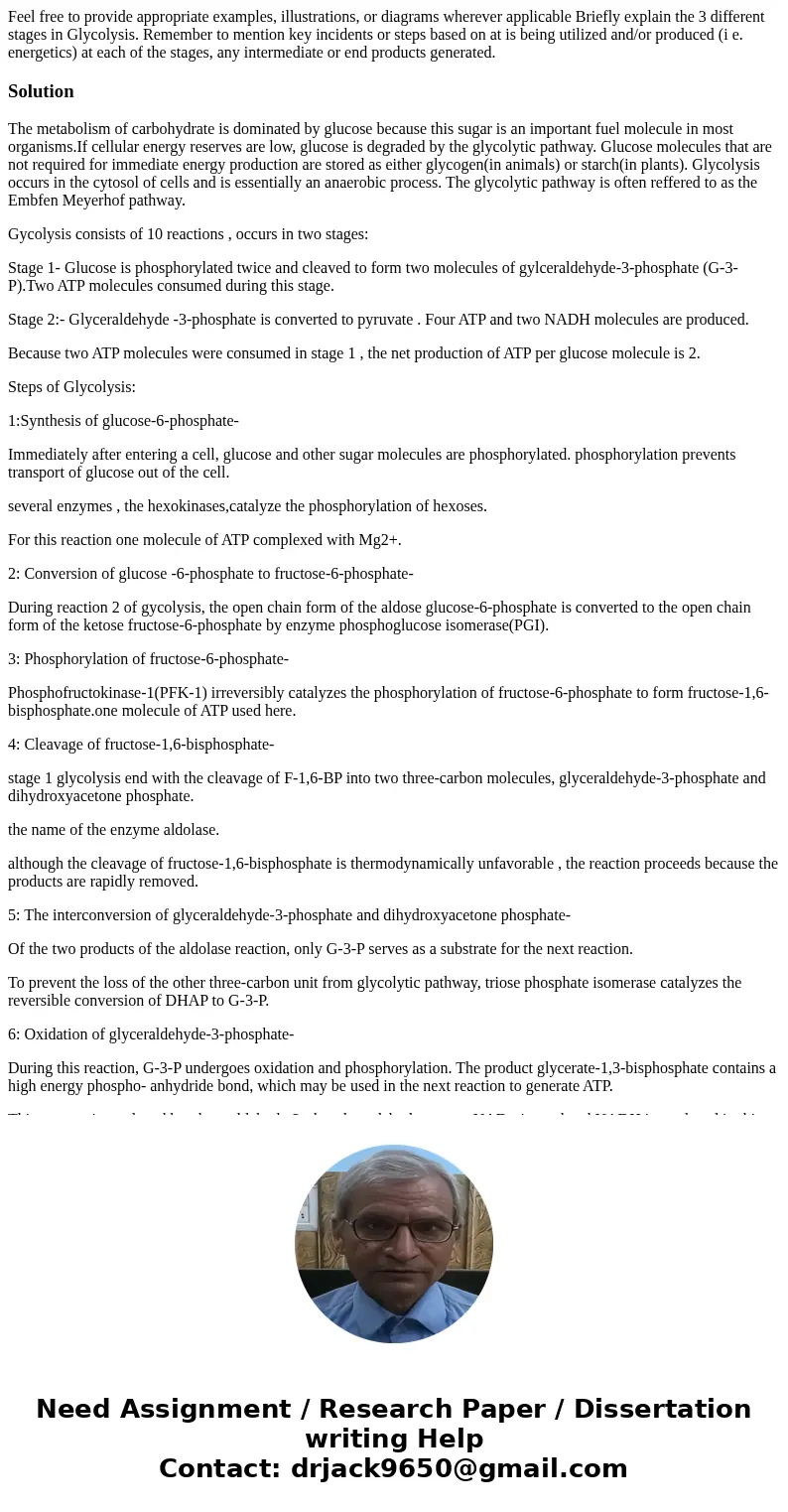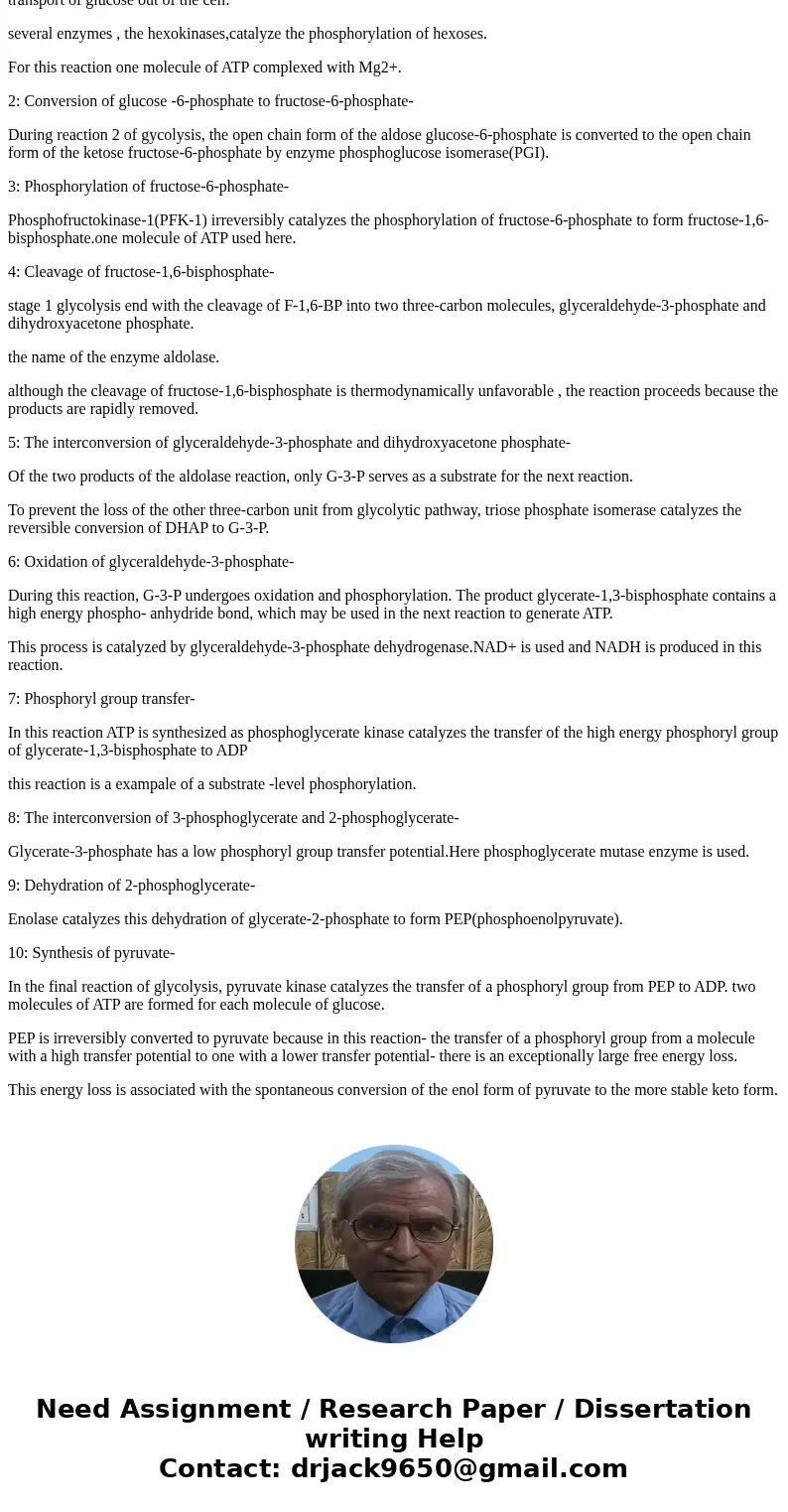Feel free to provide appropriate examples illustrations or d
Solution
The metabolism of carbohydrate is dominated by glucose because this sugar is an important fuel molecule in most organisms.If cellular energy reserves are low, glucose is degraded by the glycolytic pathway. Glucose molecules that are not required for immediate energy production are stored as either glycogen(in animals) or starch(in plants). Glycolysis occurs in the cytosol of cells and is essentially an anaerobic process. The glycolytic pathway is often reffered to as the Embfen Meyerhof pathway.
Gycolysis consists of 10 reactions , occurs in two stages:
Stage 1- Glucose is phosphorylated twice and cleaved to form two molecules of gylceraldehyde-3-phosphate (G-3-P).Two ATP molecules consumed during this stage.
Stage 2:- Glyceraldehyde -3-phosphate is converted to pyruvate . Four ATP and two NADH molecules are produced.
Because two ATP molecules were consumed in stage 1 , the net production of ATP per glucose molecule is 2.
Steps of Glycolysis:
1:Synthesis of glucose-6-phosphate-
Immediately after entering a cell, glucose and other sugar molecules are phosphorylated. phosphorylation prevents transport of glucose out of the cell.
several enzymes , the hexokinases,catalyze the phosphorylation of hexoses.
For this reaction one molecule of ATP complexed with Mg2+.
2: Conversion of glucose -6-phosphate to fructose-6-phosphate-
During reaction 2 of gycolysis, the open chain form of the aldose glucose-6-phosphate is converted to the open chain form of the ketose fructose-6-phosphate by enzyme phosphoglucose isomerase(PGI).
3: Phosphorylation of fructose-6-phosphate-
Phosphofructokinase-1(PFK-1) irreversibly catalyzes the phosphorylation of fructose-6-phosphate to form fructose-1,6-bisphosphate.one molecule of ATP used here.
4: Cleavage of fructose-1,6-bisphosphate-
stage 1 glycolysis end with the cleavage of F-1,6-BP into two three-carbon molecules, glyceraldehyde-3-phosphate and dihydroxyacetone phosphate.
the name of the enzyme aldolase.
although the cleavage of fructose-1,6-bisphosphate is thermodynamically unfavorable , the reaction proceeds because the products are rapidly removed.
5: The interconversion of glyceraldehyde-3-phosphate and dihydroxyacetone phosphate-
Of the two products of the aldolase reaction, only G-3-P serves as a substrate for the next reaction.
To prevent the loss of the other three-carbon unit from glycolytic pathway, triose phosphate isomerase catalyzes the reversible conversion of DHAP to G-3-P.
6: Oxidation of glyceraldehyde-3-phosphate-
During this reaction, G-3-P undergoes oxidation and phosphorylation. The product glycerate-1,3-bisphosphate contains a high energy phospho- anhydride bond, which may be used in the next reaction to generate ATP.
This process is catalyzed by glyceraldehyde-3-phosphate dehydrogenase.NAD+ is used and NADH is produced in this reaction.
7: Phosphoryl group transfer-
In this reaction ATP is synthesized as phosphoglycerate kinase catalyzes the transfer of the high energy phosphoryl group of glycerate-1,3-bisphosphate to ADP
this reaction is a exampale of a substrate -level phosphorylation.
8: The interconversion of 3-phosphoglycerate and 2-phosphoglycerate-
Glycerate-3-phosphate has a low phosphoryl group transfer potential.Here phosphoglycerate mutase enzyme is used.
9: Dehydration of 2-phosphoglycerate-
Enolase catalyzes this dehydration of glycerate-2-phosphate to form PEP(phosphoenolpyruvate).
10: Synthesis of pyruvate-
In the final reaction of glycolysis, pyruvate kinase catalyzes the transfer of a phosphoryl group from PEP to ADP. two molecules of ATP are formed for each molecule of glucose.
PEP is irreversibly converted to pyruvate because in this reaction- the transfer of a phosphoryl group from a molecule with a high transfer potential to one with a lower transfer potential- there is an exceptionally large free energy loss.
This energy loss is associated with the spontaneous conversion of the enol form of pyruvate to the more stable keto form.


 Homework Sourse
Homework Sourse